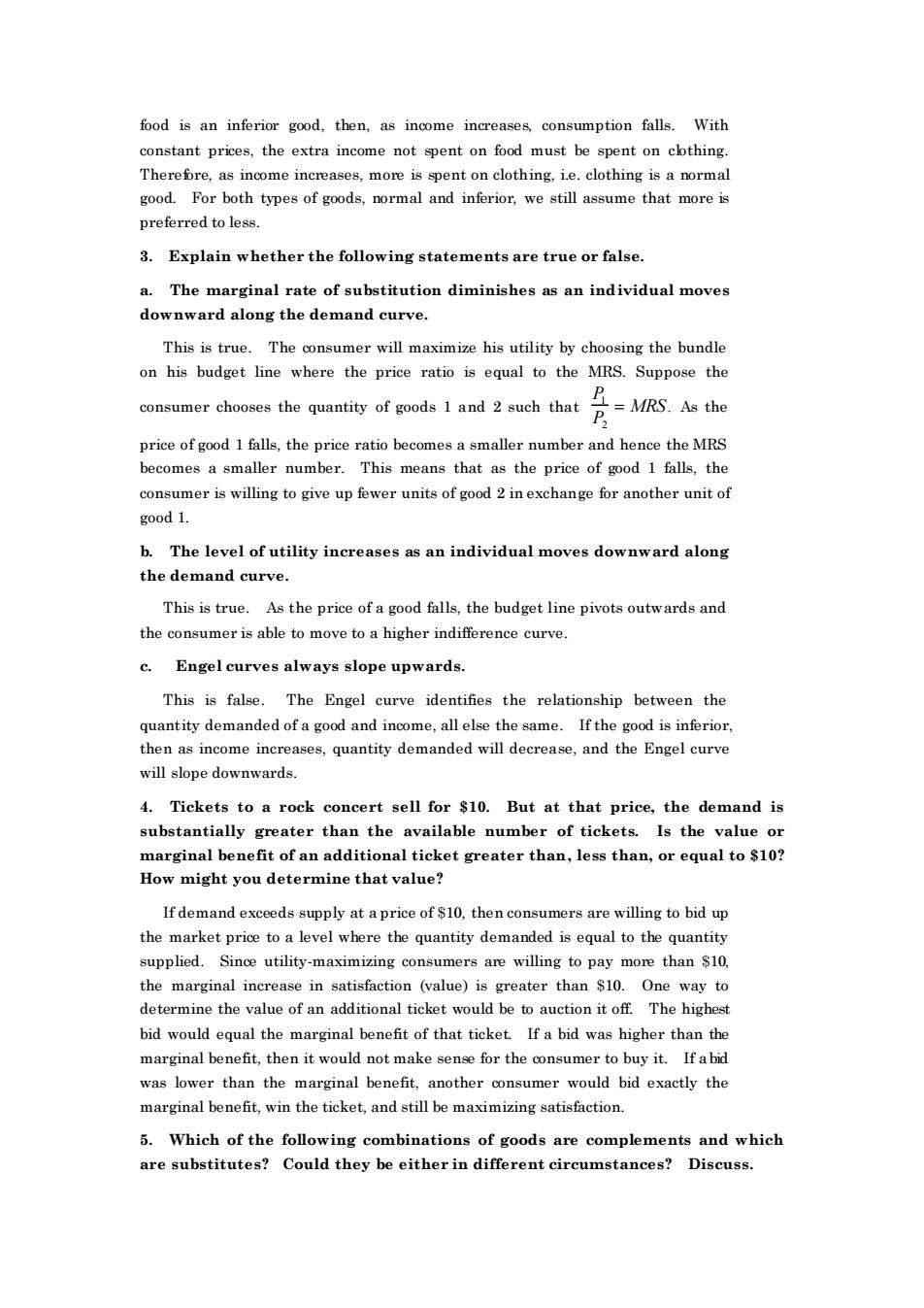正在加载图片...

food is an inferior good,then,as income increases consumption falls.With constant prices,the extra income not spent on food must be spent on clthing good.For both types of goods,normal and inferior,we still assume that more is preferred to less. 3.Explain whether the following statements are true or false. a.The marginal rate of substitution diminishes as an individual moves downward along the demand curve. This is true.The consumer will maximize his utility by choosing the bundle on his budget line where the price ratio is equal to the MRS.Suppose the =MRS.As the price of good 1 falls.the price ratio becomes a smaller number and hence the mrs becomes a smaller number.This means that as the price of good 1 falls,the another unit of good 1. b.The level of utility increases as an individual moves downward along the demand curve. This is true.As the price of a good falls,the budget line pivots outwards and the consumer is able to move to a higher indifference curve. c.Engel curves always slope upwards. This is false.The Engel curve identifies the relationship between the quantity demanded and the ame.Ifthegod isnr ases,quantity demanded will decrease,and the Engel curv will slope downwards 4.Tickets to a rock concert sell for $10.But at that price,the demand is substantially greater than the available number of tickets.Is the value or marginal benefit of an additional ticket greater than,less than,or equal to $10? How might you determine that value? If demand exceeds supply at aprice of $10.then consumers are willing to bid up the market price toa levelw here the quantity demanded is equal to the supplied. nce utility-maximizing consumers are willing to pay than $10 the marginal increase in satisfaction (value)is greater than S10 One way to determine the value of an additional ticket would be to auction it off.The highest bid would equal the marginal benefit of that ticket.If a bid was higher than the marginal benefit,then it would not make sense for the consumer to buy it.If abd was lower than arginal benefit. nother consumer ould bid exactly the marginal benefit,win the ticket,and still be maximizing satisfaction. 5.Which of the following combinations of goods are complements and which are substitutes?Could they be either in different circumstances?Discuss. food is an inferior good, then, as income increases, consumption falls. With constant prices, the extra income not spent on food must be spent on clothing. Therefore, as income increases, more is spent on clothing, i.e. clothing is a normal good. For both types of goods, normal and inferior, we still assume that more is preferred to less. 3. Explain whether the following statements are true or false. a. The marginal rate of substitution diminishes as an individual moves downward along the demand curve. This is true. The consumer will maximize his utility by choosing the bundle on his budget line where the price ratio is equal to the MRS. Suppose the consumer chooses the quantity of goods 1 and 2 such that P1 P2 = MRS. As the price of good 1 falls, the price ratio becomes a smaller number and hence the MRS becomes a smaller number. This means that as the price of good 1 falls, the consumer is willing to give up fewer units of good 2 in exchange for another unit of good 1. b. The level of utility increases as an individual moves downward along the demand curve. This is true. As the price of a good falls, the budget line pivots outwards and the consumer is able to move to a higher indifference curve. c. Engel curves always slope upwards. This is false. The Engel curve identifies the relationship between the quantity demanded of a good and income, all else the same. If the good is inferior, then as income increases, quantity demanded will decrease, and the Engel curve will slope downwards. 4. Tickets to a rock concert sell for $10. But at that price, the demand is substantially greater than the available number of tickets. Is the value or marginal benefit of an additional ticket greater than, less than, or equal to $10? How might you determine that value? If demand exceeds supply at a price of $10, then consumers are willing to bid up the market price to a level where the quantity demanded is equal to the quantity supplied. Since utility-maximizing consumers are willing to pay more than $10, the marginal increase in satisfaction (value) is greater than $10. One way to determine the value of an additional ticket would be to auction it off. The highest bid would equal the marginal benefit of that ticket. If a bid was higher than the marginal benefit, then it would not make sense for the consumer to buy it. If a bid was lower than the marginal benefit, another consumer would bid exactly the marginal benefit, win the ticket, and still be maximizing satisfaction. 5. Which of the following combinations of goods are complements and which are substitutes? Could they be either in different circumstances? Discuss